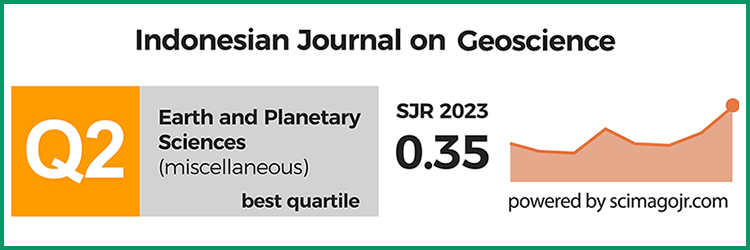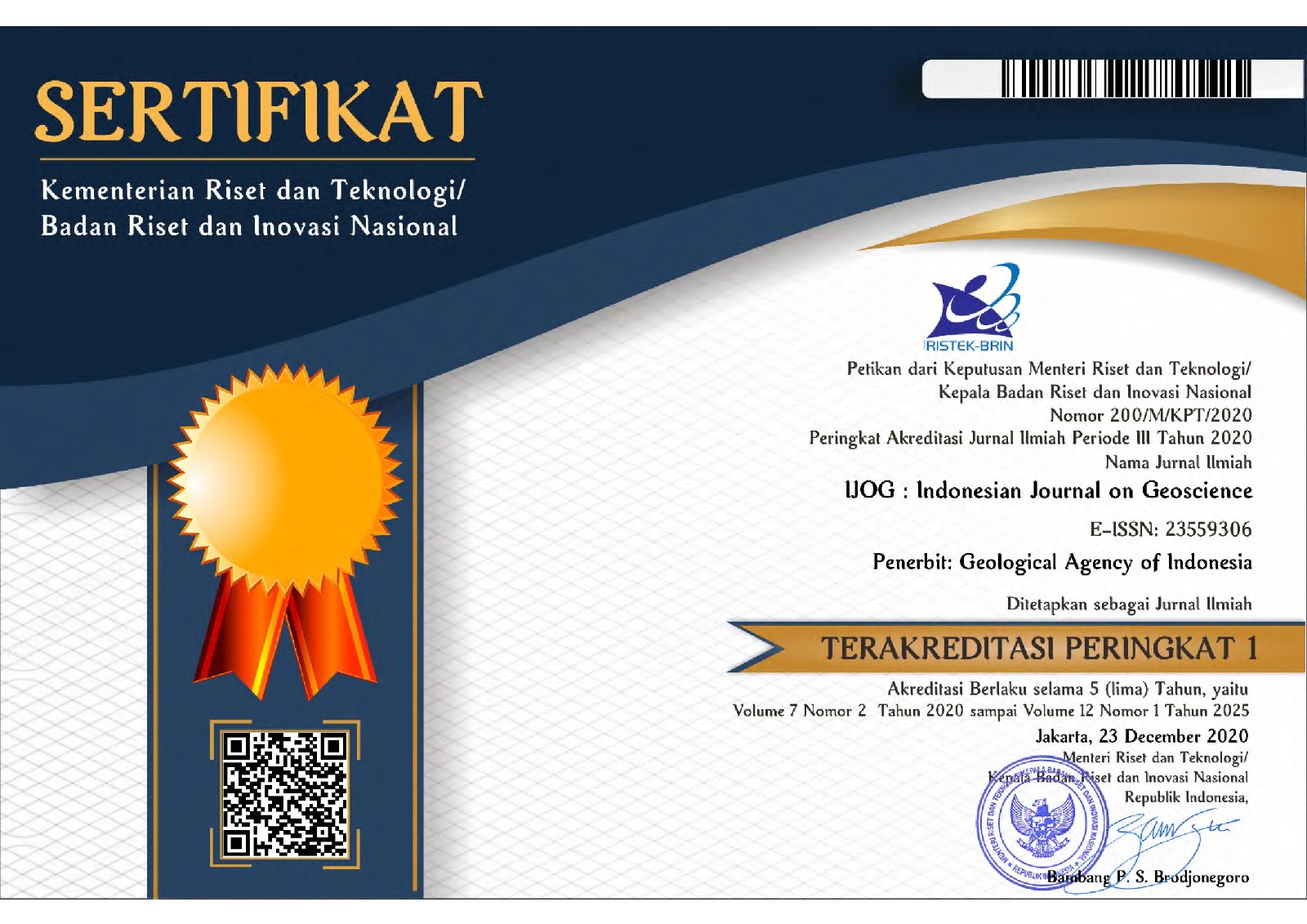Mechanism of High Frequency Shallow Earthquake Source in Mount Soputan, North Sulawesi
DOI:
https://doi.org/10.17014/ijog.6.3.135-144Keywords:
moment tensor, source mechanism, frequency, P-wave, polarity, first motionAbstract
Moment tensor analysis had been conducted to understand the source mechanism of earthquakes in Soputan Volcano during October - November 2010 period. The record shows shallow earthquakes with frequency about 5 - 9 Hz. Polarity distribution of P-wave first onset indicates that the recorded earthquakes are predominated by earthquakes where almost at all stations have the same direction of P-wave first motions, and earthquakes with upward first motions.In this article, the source mechanism is described as the second derivative of moment tensor, approached with first motion amplitude inversion of P-wave at some seismic stations. The result of moment tensor decomposition are predominated by earthquakes with big percentage in ISO and CLVD component. Focal mechanism shows that the recorded earthquakes have the same strike in northeast-southwest direction with dip about 400 - 600. The sources of the high frequency shallow earthquakes are in the form of tensile-shear cracks or a combination between crack and tensile faulting.
References
Aki, K. dan Richards, P.G., 1980. Quantity Seismology: Theory and Methods. W.H. Freeman, New York.
Dahm, T., 1996. Relative moment tensor inversion based on ray theory: Theory and synthetic test. Geophysical Journal International, 124, h.245-257. DOI:10.1111/j.1365-246X.1996.tb06368.x
Iguchi, M., 1994. A vertical expansion source model for mechanism of earthquakes originated in the magma conduit of andesitic volcano: Sakurajima, Japan. Bulletin of Volcanological Society of Japan.
Julian, B.R., Miller, A.D., dan Foulger, G.R., 1997. Non-double-couple earthquake mechanisms at the Hengill-Grensdalur volcanic complex, southwest Iceland. Geophysical Research Letters, 24, h.743-746. DOI:10.1029/97GL00499
Jost, M.L. dan Hermann, R.B., 1989. A student’s guide to and review of moment tensor. Seismology Research Letters, 60.
Knopoff, L., dan Randall, M. J. 1970. The compensated linear vector dipole: A possible mechanism for deep earthquakes. Journal of Geophysical Resources, 75, h. 4957-4963. DOI:10.1029/JB075i026p04957
Moechtar, H., Pratomo, I., dan Mulyana, H., 2007. Gerakan struktur dan kaitannya dengan faktor kendali tektonik, berdasarkan analisis stratigrafi; Studi kasus geologi kuarter terhadap fase perkembangan Danau Tondano purba sepanjang Remboken - Kakas, Kec. Remboken dan Kec. Kakas, Kab. Tomohon, Sulawesi Utara. Jurnal Geologi Indonesia, 2(3), h.182. DOI:10.17014/ijog.vol2no3.20075
Nishi, K., 2001. A three-dimensional robust seismic ray tracer for volcanic regions. Earth Planet Space, 53, h. 101-109. DOI:10.1186/BF03352367
Ratdomopurbo, A., 1992. Étude de séismes de type-A du volcan Merapi (Indonésie). DEA Report, Univ. Joseph Fourier Grenoble I, Grenoble, 60 h.
Shimizu, H., Ueki, S., dan Koyama, J., 1987. A tensile-shear crack model for mechanism of volcanic earthquakes. Tectonophysics, 144, h.287-300. DOI:10.1016/0040-1951(87)90023-0
Sipkin, S.A., 1986. Interpretation of non-double couple earthquake mechanisms derived from moment tensor inversion. Journal of Geophysical Research, h.531-547. DOI:10.1029/JB091iB01p00531
Triastuty, H., Iguchi, M., dan Tameguri, T., 2006. Source mechanism of monochromatic and low-frequency events at Papandayan volcano, West Java, Indonesia. Indonesian Journal of Physics, 17(3), h.63-72.
Vavrycuk, V., 2001. Inversion for parameters of tensile earthquakes. Journal of Geophysical Research, h. 106. DOI:10.1029/2001JB000372
Vavrycuk, V., 2005. Focal mechanisms in anisotropic media. Geophysical Journal International, 161, h.334-336. DOI:10.1111/j.1365-246X.2005.02585.x



















